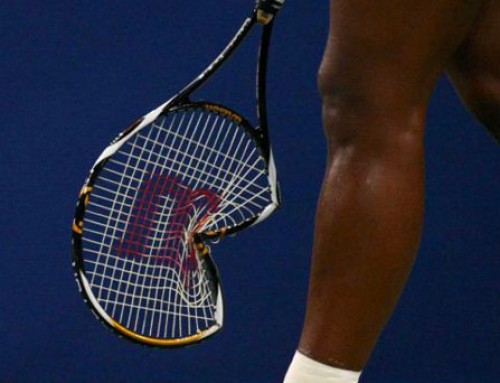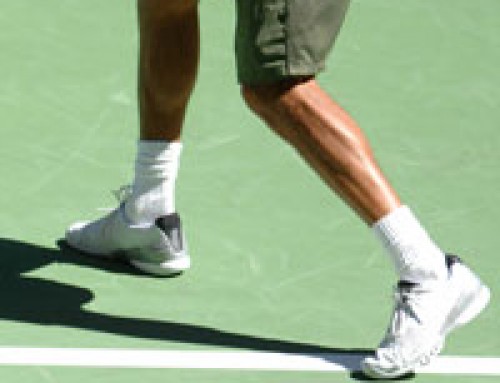 Digital video has revolutionized so many aspects of our lives in the past decade, including how we learn and interact as tennis enthusiasts. It wasn’t so long ago that the only way we could view video of tennis players was either on TV or by checking out tapes at your local library. Nationally recognized tennis pros and coaches would often times come out with instructional videos as well which you could purchase from the backs of magazines or at tennis conventions.
Digital video has revolutionized so many aspects of our lives in the past decade, including how we learn and interact as tennis enthusiasts. It wasn’t so long ago that the only way we could view video of tennis players was either on TV or by checking out tapes at your local library. Nationally recognized tennis pros and coaches would often times come out with instructional videos as well which you could purchase from the backs of magazines or at tennis conventions.
These days absolutely anybody with an entry level camera, entry level computer, and connection to the internet can become a star on the tennis court. Below I’ve outlined the top 5 components of creating your own videos so that you can receive the best feedback and instruction possible. Follow these instructions and your videos will be a pleasure to watch instead of a pain.
Camera
Digital video doesn’t cost an arm and a leg anymore. In fact, you can now get full HD quality video right to your computer screen for less than $200. Hands down my favorite way of shooting high quality digital video on the cheap is the Flip UltraHD camera. This camera fits completely in one hand, takes two hours of HD quality video, and can be had for as little as $155. For examples of the video quality coming from this camera check out the point play analysis shown in the Video section of Essential Tennis.
The Flip Cam isn’t the only option for HD quality video at a cheap price. Take a little around Amazon.com and you’ll be surprised how many different companies are jumping on board to give us tennis players a wide variety of hardware.
Tripod
Sounds like a no brain-er, right? Well believe it or not people submit videos of themselves to me that were shot without the use of a tripod all the time. Do your viewers a favor and make a small investment in one of these incredibly useful devices, otherwise you’ll have myself and other tennis enthusiasts reaching for the motion sickness meds faster than you can say “action!”. This does not have to cost a lot of money! People are always surprised when I tell them that they can pick up a tripod to do the job for under $20, but it’s true. Here’s a link to a full sized tripod on Amazon that costs only $16 with shipping included. A favorite of mine is also the “Gorillapod” mini tripod that has flexible arms to wrap around things like a fence or net post. This is really cool when combined with my little FlipCam, especially since it only costs $17 on Amazon.
Framing
Your video camera is able to “see” a certain amount of space on the court and where you place yourself within that space is your framing. I often times see stroke videos where the subject is literally on the other side of the court, barely taking up any space in the frame. This makes it extremely tough to pick out technique keys and give good feedback to players. On the other hand, if you’re looking for feedback on strategy and point play you want to be able to see as much of the court as possible, which means both players are going to take up much less room in the frame. It totally depends on what you’re trying to get information on, strokes or point play. Do your viewers a favor and put a lot of thought into setting up your camera and tripod properly so that everybody can clearly see what you’re trying to show them!
Stroke technique videos: fill the frame as much as possible without leaving it constantly. Point play videos: place the camera to see as much of the court as possible. At the top of the back fence pointing down is definitely the best.
One more thing about framing your shot for stroke technique. In my opinion the two most useful angles to view tennis strokes from are either directly to the side of the player (90 degrees to the right or left) or directly behind the player looking forwards towards the net. Pointing your camera towards you from the other side of the net or skewed off to the side at a random angle makes it a bit more difficult to give the best technical feedback possible.
Editing
Have you thought about editing your technique or point play videos? I’m not talking about color correction, chroma key, or anything else fancy like that. What I suggest is simply cutting around your most important content to make it easy for your audience to watch. When editing out all of the dead time in a typical 6-4 set there’s actually only 6-10 minutes of actual play time. Not only will it be that much easier and faster to watch, but when all of the points are back to back it’s much easier to pick out patterns in the match play without all of the time searching for balls and taking water breaks in between. Just like tripods and cameras, it’s not necessary to spend a lot of money to get this done. In MacOS iMovie is definitely the way to go, very easy to use and included with the operating system. If you’re a Windows user then a great free option is Windows Movie Maker.
Publishing
Obviously YouTube is the most popular way to put your videos up for the world to see. Some tennis players don’t want their content to be available for just anybody to see, however. Within YouTube are a vast array of privacy settings, including ways to create private links that only certain people can access. It’s totally up to you how public or private your videos will be. Keep in mind that YouTube limits the length of your uploads to only 10 minutes, and file sizes have to be within 2gigs. Alternatives to YouTube include blip.tv, Vimeo.com, and Viddler.com.
Once your videos are published to a video hosting web site make sure to drop by the Forums at Essential Tennis to receive free feedback from certified tennis professionals!
Also, speaking of video, my friend Florian Meier has started posting some awesome tennis instruction of his own. Check it out at www.onlinetennisinstruction.com. Lots of free stuff to learn from!







